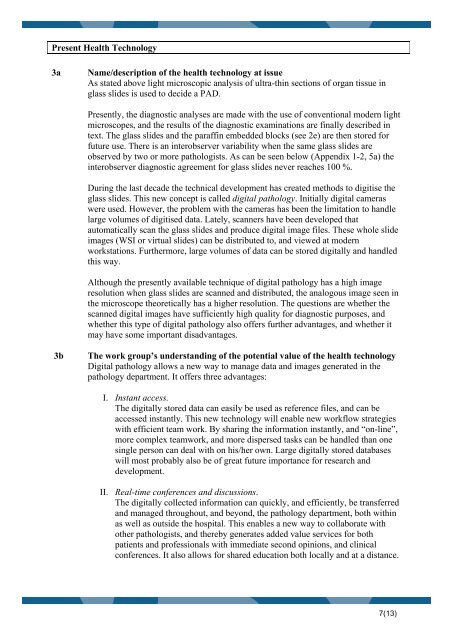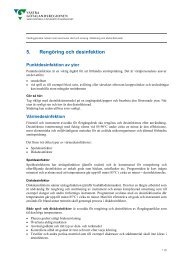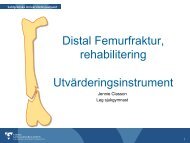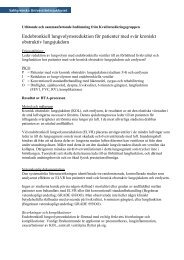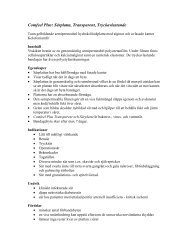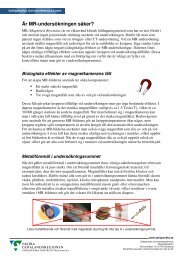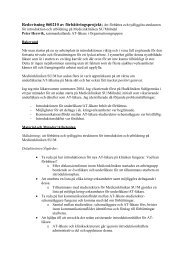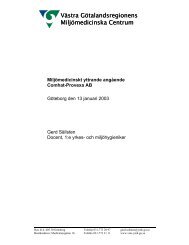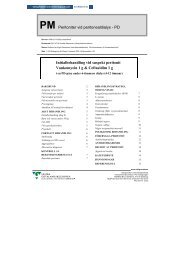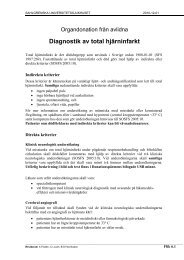Diagnostisk överensstämmelse mellan inscannade digitala ...
Diagnostisk överensstämmelse mellan inscannade digitala ...
Diagnostisk överensstämmelse mellan inscannade digitala ...
You also want an ePaper? Increase the reach of your titles
YUMPU automatically turns print PDFs into web optimized ePapers that Google loves.
Present Health Technology<br />
3a Name/description of the health technology at issue<br />
As stated above light microscopic analysis of ultra-thin sections of organ tissue in<br />
glass slides is used to decide a PAD.<br />
Presently, the diagnostic analyses are made with the use of conventional modern light<br />
microscopes, and the results of the diagnostic examinations are finally described in<br />
text. The glass slides and the paraffin embedded blocks (see 2e) are then stored for<br />
future use. There is an interobserver variability when the same glass slides are<br />
observed by two or more pathologists. As can be seen below (Appendix 1-2, 5a) the<br />
interobserver diagnostic agreement for glass slides never reaches 100 %.<br />
During the last decade the technical development has created methods to digitise the<br />
glass slides. This new concept is called digital pathology. Initially digital cameras<br />
were used. However, the problem with the cameras has been the limitation to handle<br />
large volumes of digitised data. Lately, scanners have been developed that<br />
automatically scan the glass slides and produce digital image files. These whole slide<br />
images (WSI or virtual slides) can be distributed to, and viewed at modern<br />
workstations. Furthermore, large volumes of data can be stored digitally and handled<br />
this way.<br />
Although the presently available technique of digital pathology has a high image<br />
resolution when glass slides are scanned and distributed, the analogous image seen in<br />
the microscope theoretically has a higher resolution. The questions are whether the<br />
scanned digital images have sufficiently high quality for diagnostic purposes, and<br />
whether this type of digital pathology also offers further advantages, and whether it<br />
may have some important disadvantages.<br />
3b The work group’s understanding of the potential value of the health technology<br />
Digital pathology allows a new way to manage data and images generated in the<br />
pathology department. It offers three advantages:<br />
I. Instant access.<br />
The digitally stored data can easily be used as reference files, and can be<br />
accessed instantly. This new technology will enable new workflow strategies<br />
with efficient team work. By sharing the information instantly, and “on-line”,<br />
more complex teamwork, and more dispersed tasks can be handled than one<br />
single person can deal with on his/her own. Large digitally stored databases<br />
will most probably also be of great future importance for research and<br />
development.<br />
II. Real-time conferences and discussions.<br />
The digitally collected information can quickly, and efficiently, be transferred<br />
and managed throughout, and beyond, the pathology department, both within<br />
as well as outside the hospital. This enables a new way to collaborate with<br />
other pathologists, and thereby generates added value services for both<br />
patients and professionals with immediate second opinions, and clinical<br />
conferences. It also allows for shared education both locally and at a distance.<br />
7(13)


